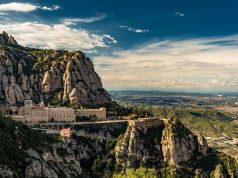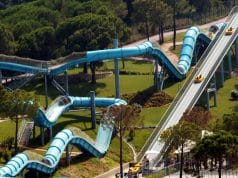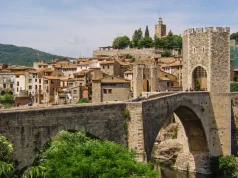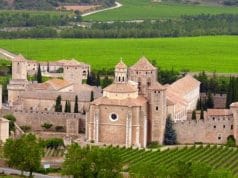The Roman ruins of Tarragona now a UNESCO World Heritage Site. There are many examples of the Roman remains to discover what used to be the Roman city of Tarraco. The old Roman city of Tarraco is today known as Tarragona city.
The Roman city of Tarraco was the oldest Roman settlement in Iberia. It became the capital of Hispania Citerior between the periods of the Roman Republic and Hispania Tarraconensis. Well-preserved Roman walls surround parts of the city. The Roman Circus (Circ Romà) home to chariot racing, the famous Amphitheater of Tarraco built in the 2nd century AD. The Roman Theatre of Tarraco ruins, The Ferreres Aqueduct and several other historic Roman buildings and monuments can be visited all around Tarragona. The Roman ruins of Tarragona are some of the best preserved of any former Roman city in Catalyuna, and well worth visiting.
Tarragona has unique examples of Roman ruins from an ancient Roman city within Spain. Undoubtedly, Tarragona is well worth a visit for all those who are interested in Roman history.

Notable Roman Ruins In Tarragona
Tarragona is fortunate that many of the historic ruins of the old Roman city of Tarraco are visible within the city.
Tarragona is unique in that many Roman ruins and remains of several important Roman buildings remain. Many of these buildings remain in a well-preserved state, considering their age. The city of Tarragona has become an essential place to visit for people with an interest in the Roman Empire. Many of these ruins formed part of the city, most can be discovered and viewed free of charge. Below we highlight some of the most significant remains from the old Roman city of Tarraco.
- TARRAGONA AMPHITHEATRE – A well-preserved Roman amphitheater built at the end of the 1st century and the start of the 2nd century AD. Its maximum capacity at the time was able to accommodate 15,000 spectators.
- ROMAN CIRCUS – The Roman circus built in the 1st century AD before the amphitheater. It also had room for around 30,000 spectators, twice the amount of the city’s amphitheater. Its use was for chariot racing and circus performers. During its lifetime, it was used as a palace and even a prison.
- THE FERRERES AQUEDUCT – Located a few kilometers north of Tarragona. This aqueduct was fundamental in supplying water to the Roman city of Tarraco. Construction was between 27 BC and 14 AD in the time of Augustus. This well-preserved monument stands 27 meters high, 249 meters long and has 25 arches.
- ROMAN WALLS OF TARRAGONA – As the name suggests, these are the remains of the Roman walls. These stone walls once protected the city of Tarraco. Constructed in the 2nd century BC, around 1.1 km of walls remain. Some parts of the city walls have aged very well.
- BERÀ ARCH – You can find this historic Roman monument around 20 kms from Tarragona along the Via Augusta. The arch was built in the late 1st century BC for Licinius Sura. The monument is in excellent condition for it current age of over 2000 years old.
- LOCAL FORUM – This used to be a main square that featured in its time shops and temples. Much was destroyed of the Local Forum as the city expanded in the 10th century. However there are still a large selection of ruins of the Local Forum to visit.
- PROVINCIAL FORUM REMAINS – These are several interesting remains of the Provincial Forum that are mixed in with current urban life. The remains can be viewed at the Plaça del Rei, Plaça del Pallol and Plaça del Fòrum.
- ROMAN THEATRE – One of three Roman entertainment sites in Tarragona. The theatre built during the time of Augustus during the 1st century AD. It was saved from destruction during the construction boom of the 1970’s. Since then it has since been preserved for future generations to enjoy.
- MÈDOL QUARRY – Located around 7.5 kms from Tarragona. This is the quarry the Romans sourced stone for the construction of the city. Many blocks of extracted stone are still visible, as is the Mèdol Spire, a 20-meter tall Roman monolith.
As outlined in the above list of the most important Roman ruins of Tarragona, there are numerous sites to visit. If you would really like to dig in deep and explore the Roman ruins of Tarragona, we suggest staying overnight. Having a full couple of days would give you an opportunity to explore most of Tarragona’s Roman ruins.
National Archaelogical Museum Of Tarragona
All the history of Tarraco have been preserved within the MNAT museum in Tarragona.
Many of Tarragonas Roman artifacts and remains have been preserved in the National Archaeological Museum (MNAT) in Tarragona. The museum is in the Plaça del Rei and has a unique and rare selection of priceless Roman ruins. There are many exhibits of sculptures, mosaics, and fragments of Roman life. There is also, within the basement of the museum, a section of the city’s original Roman Wall.
The MNAT Museum is a collection of venues safe keeping the Roman history of Tarragona. Some of the sites that form part of the National Archaelogical museum include The Roman Theatre, Barà Arch, Tower of the Scipios. Also included is The Monumental complex of Centcelles and The Roman Villa of Els Munts. The museums of Necropolis and Tinglado 4 in the port are also part of MNAT.
How Do You Get To Tarragona From Barcelona?
Find out how to arrive at Tarragona in just 30 minutes from Barcelona.
The best way to get from Barcelona to Tarragona is by train. There are express trains or regional trains that will take you to Tarragona. If you catch one of the express trains, this will take less than half the time of the regional trains. If you catch one of the inter-city express trains, you will arrive in Tarragona in about 30 minutes. This is compared to an hour by regional trains.
You may wish to travel by car or bus from Barcelona to Tarragona. If you are travelling by car, you can take the C-32 and AP 7 motorways to Tarragona. The journey time is around one hour 10 minutes, depending on traffic conditions. If you are travelling by bus, opt for a bus that will travel direct to Tarragona without other stops. The journey time will be about an hour and a half. As there is so much to see in Tarragona, opt for travelling by train from Barcelona Sants Station.













